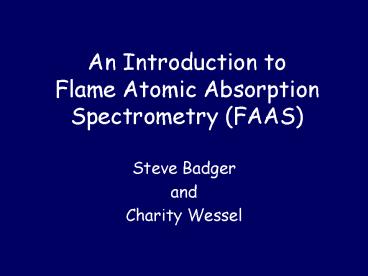An Introduction to Flame Atomic Absorption Spectrometry FAAS - PowerPoint PPT Presentation
1 / 27
Title:
An Introduction to Flame Atomic Absorption Spectrometry FAAS
Description:
An Introduction to Flame Atomic Absorption Spectrometry FAAS – PowerPoint PPT presentation
Number of Views:734
Avg rating:3.0/5.0
Title: An Introduction to Flame Atomic Absorption Spectrometry FAAS
1
An Introduction toFlame Atomic Absorption
Spectrometry (FAAS)
- Steve Badger
- and
- Charity Wessel
2
Introduction
- FAAS, developed in the 1950s, is a common method
of quantitative analysis of many elements - FAAS is extensively used to determine trace
quantities of elements in biological,
environmental, clinical, geological, and edible
samples. - Elemental health hazards can be detected with
0.0331 error.
3
Theory of Operation
- Structure of an atom
- Atoms consist of a nucleus and electrons.
- The nucleus contains protons and neutrons.
- The negatively charged electrons are located in
orbitals around the nucleus. - When electrons occupy the innermost available
orbital, their energy is at a minimum (ground
state).
4
Theory of Operation, continued
- When atoms are subjected to heat or some form of
EMR, one or more electrons jump to a higher
energy level, leaving a vacancy in the inner
shell - We say the electron is excited
- As this happens, energy is absorbed
5
Theory of Operation, continued
- When the excited electron in the outer orbital
returns to the lower energy level of the inner,
vacant orbital, energy is released in the form of
a photon
6
Theory of Operation, continued
- Because the atoms of each element have a
different electronic structure, each one emits
light of different wavelengths - In FAAS, the concentration of an element present
in a sample can be measured by noting the
absorbance caused by the excited sample
7
Instrument Design
- FAAS components
- Fuel (acetylene)
- Oxidizer (air, N2O)
- Hollow Cathode Lamp (HCL)
- Nebulizer
- Burner Head
- Flame
- Exhaust hood
8
Instrument Design Acetylene
- Acetylene is a flammable, compressed gas that is
used as a fuel for FAAS. - During FAAS operation, the valve connected to the
acetylene cylinder is opened completely. - Storing the tank in a lab can be extremely
dangerous. - That is why the tanks are supported upright with
a metal chain.
9
Instrument Design HCL
- The HCL is a glass tube filled with an inert gas
(neon, argon, or helium) and the pure element to
be subjected to FAAS. - The atoms of the element become ionized and
excited when the FAAS is on.
10
Instrument Design HCL
- The spectrum emitted by the HCL corresponds to
the element in the cathode - For example, if a Cd HCL is used, the
characteristic wavelengths of Cd are emitted
11
Do you recall emission spectra from general
chemistry?
12
7.3
13
Instrument Design HCL
- Single-element HCLs generally achieve greater
sensitivity - On the other hand, multi-element HCLs save money
14
Instrument Design Burner Head
- The burner head is made of titanium
- This is where the sample atoms are excited
15
Instrument Design Nebulizer
- The nebulizer changes liquid sample to a mist
- This arrow is pointing to the nebulizer
16
Instrument Design Flame
- The flame is ignited by pushing the red burner
button on the instrument - The maximum temperature of the air-acetylene
flame is 3,095C
17
Typical Units of Concentration
- Parts Per Million (ppm)
- A unit of concentration often used when measuring
levels of pollutants in air, water, body fluids,
etc. - 1.00 ppm is equal to 1.00 mg/liter
- And 1.00 ?g/mL
18
Typical Units of Concentration
- Parts Per Billion (ppb)
- Another typical concentration unit used when
measuring trace levels of pollutants in air,
water, body fluids, etc. - 1.00 ppb is equal to 1.00 ?g/liter
19
Preparation of Standards
- Typically 4-5 standards and a blank are prepared
to construct a calibration curve (a/k/a a
standard curve) - When preparing your solutions, think about the
need for precision, low contamination, and
minimal waste - Standard solutions should be prepared using
appropriate glassware and distilled water - Consult a reference to determine appropriate
concentrations of standards for a given element
20
Constructing a Calibration Curve
- As with other analytical techniques, FAAS
requires careful calibration - The absorbance of the standards are plotted
versus concentration - The plot often deviates from a straight line
21
Preparation of Samples
- A standard reference should be consulted to
determine appropriate methods of preparing
various samples for FAAS
22
Operation
- Open the valve on top of the acetylene cylinder
completely. - Turn on the exhaust vent using the switch on the
hood. - Turn on the workstation connected to the FAAS.
- Load the FAAS software.
23
Operation Optimization
- Only a few steps are required for optimization
- The software steps you through the optimization,
because a method has already been created for
doing so - After optimization, you are now ready to start
the analysis
24
Analysis
- Again, the software leads you through the
procedure - Sequentially aspirate the blank (distilled
water), the calibration standards, and the
samples
25
Evaluation of Results
- After the analyses are complete, look at the
calibration curve printed out by the FAAS
systems printer
26
Limitations of FAAS
- The chemical form of the analyzed element is not
detected - For example, if copper was being analyzed, all
that would be known is how much copper is
present. - It would not be known if it is copper(II)
cyanide, copper(III) sulfate, etc. - The preparation of the standards and samples can
be time consuming - The whole FAAS procedure requires detailed work
- Some elements cannot be examined by FAAS
- The FAAS procedure destroys the sample
27
Conclusion
- FAAS is an accurate method of quantitative
analysis for many elements






























